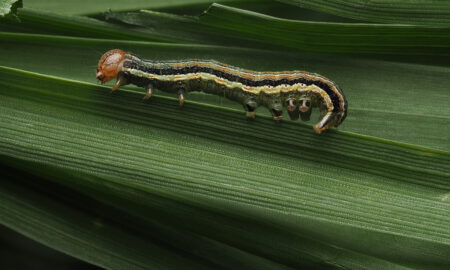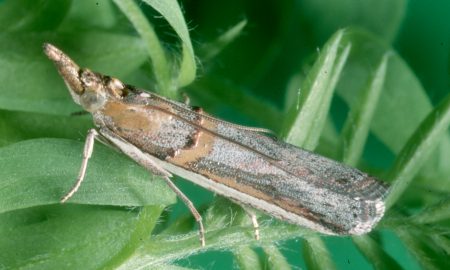Key takeaway: Each spring, native budworm moths migrate from inland Australia into crops. Rainfall in inland areas may boost moth numbers by increasing host plants, but outbreak years are still unpredictable. On-farm monitoring with traps, sweep nets, and beatsheets is the only reliable way to stay ahead of larval outbreaks.
A migratory species
Autumn and winter temperatures are too cold for native budworm (Helicoverpa punctigera) development in southeastern Australia.
During colder months, native budworm is believed to breed in the arid inland of Australia, where temperatures are mild enough for development and seasonal rainfall supports the native host plants they feed on.
With the onset of spring, conditions inland become far less suitable for native budworm development, as temperatures rise and suitable hosts mature and die off. Adult moths then migrate thousands of kilometres to cropping regions, where they lay eggs in pulses and canola approaching flowering.
But could rainfall in the arid interior earlier in the season influence the size of these moth flights?
Rainfall and moth migration
The theory is that more rain inland promotes an abundance of host plant material allowing moth populations to increase.
For example, as reported in the Beatsheet, native budworm breeding regions in southwest Queensland received near-record rainfall over the past six months, and moth traps in southwest and central Queensland are capturing higher-than-average moth numbers.
In spring 2024, southeastern crops also saw unusually high numbers of native budworm larvae, which we suggested might have been linked to the above-average rainfall in parts of the arid inland.
However, research on the association between inland rainfall during autumn and winter and the size of the first moth flights in spring isn’t straightforward. One study showed a positive correlation and another showed no correlation. So, while rainfall may provide favourable conditions for native budworm inland, predicting the scale of spring flights to southeastern Australia remains tricky.
Monitor, monitor, monitor
The population dynamics of native budworm are complex, likely driven by interactions between environmental factors and its biology. This makes it hard to predict seasonal risk. We can’t yet forecast the exact size or timing of moth flight show the size of moth flights translates to numbers of larvae in the field.
Hence, monitoring is so important for successfully managing this species and giving us greater confidence in decision-making.
Pheromone traps (see Learn more) can give an early heads-up on moth arrivals in late winter and spring.
As crops progress through flowering towards podding, getting out into crops with a sweep net and/or beatsheet is crucial for estimating larval numbers.
For more information on monitoring methods, crop susceptibility, and calculating thresholds, visit our native budworm PestNote (see Learn more).
Learn more
Native budworm Pestnote, Cesar Australia and SARDI
The ins and outs of native budworm moth trapping in winter grain crops, Julia Severi
Cover image: Photo by Andrew Weeks, Cesar Australia





